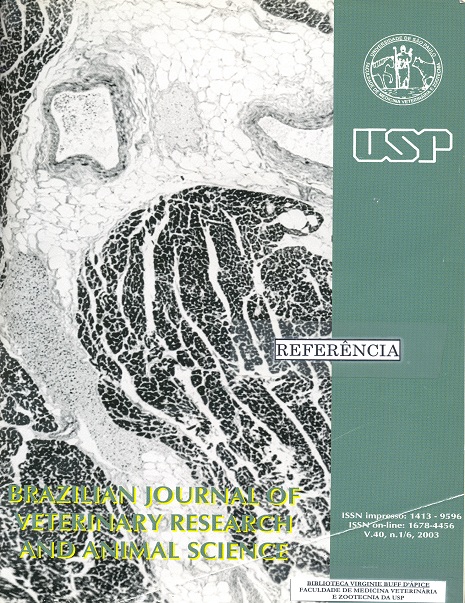Segmentation of the lung of the fetuses of zebu-crossed bovines
DOI:
https://doi.org/10.1590/S1413-95962003000200002Keywords:
Lung, Bovine, AnatomyAbstract
We studied in the present work 30 lungs of fetuses of bovines zebu-crossed, between males and females, of different ages, that were collected at the Frigorífico Boi Rio, municipal district of São José do Rio Preto, state of São Paulo. The lungs were placed in running water by 3 hours, with objective of removing the excess of blood from the organ. After washings, lungs were placed in recipient containing 20.00% aqueous solution of formaldehyde for period non inferior to 72 hours, with objective of fastening the organ. Before dissecting the lung parenchyma, we identified the limit of the hilo, in order to determine where had been outside and inside the parenchyma. We observed that the lungs of fetuses of zebu-crossed bovine can present 9 segments (3.33%), 10 segments (80.00%) or 11 segments (16.66%). The pattern to name the segments was based on the macroscopic visualization of the bronch lobares before they penetrating in the lung parenchyma. Once observed, it was named according to the pattern of the position, in other words, cranial, medium and flow, and soon after the name of the lung lobulus.Downloads
Download data is not yet available.
Downloads
Published
2003-01-01
Issue
Section
UNDEFINIED
License
The journal content is authorized under the Creative Commons BY-NC-SA license (summary of the license: https://
How to Cite
1.
Trindade LB de, Andrade EAA de, Melo APF de. Segmentation of the lung of the fetuses of zebu-crossed bovines. Braz. J. Vet. Res. Anim. Sci. [Internet]. 2003 Jan. 1 [cited 2024 Apr. 19];40(2):95-9. Available from: https://www.revistas.usp.br/bjvras/article/view/11365





